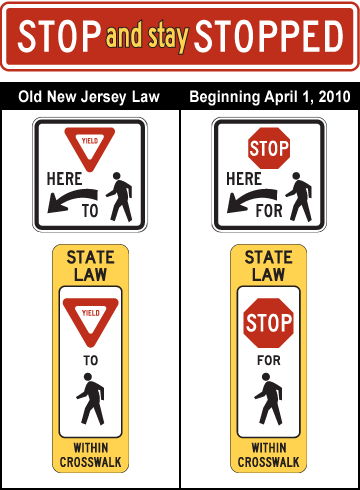Trenton
-- Attorney General Paula T. Dow and Division
of Highway Traffic Safety Director Pam Fischer
today reminded motorists that effective
April 1, they must now stop - and remain
stopped -- for pedestrians in the crosswalk.
Prior to this legislative change, motorists
were required to yield to pedestrians in
the crosswalk.
“For years, too many pedestrians have
been dying in traffic accidents in New Jersey,”
said Attorney General Dow. “With these
changes to our law, motorists and pedestrians
will no longer have to play a game of chicken
when it comes to maneuvering on our roadways.
The law brings new clarity that drivers
must stop and remain stopped for pedestrians
at intersections and crosswalks, and pedestrians,
in turn, must use due care and not jaywalk
or step into traffic outside of those crossing
points.”
Division
of Highway Traffic Safety Director Pam Fischer
explained that the agency will be working
with law enforcement officials to educate
both motorists and pedestrians about the
change in the law.
“We’re
asking law enforcement officials, when interacting
with motorists and pedestrians, to educate
them about the change to the law, as well
their respective duties and responsibilities
when walking or driving,” said Director
Fischer. “Our goal is to reinforce
the importance of pedestrians always using
crosswalks, their safety zone, and for motorists
to recognize that when approaching crosswalks
they must be alert for pedestrians and stop
and stay stopped to allow them to cross
safely.
“We
recognize that we cannot change everyone’s
behavior overnight; this will take sustained
effort over a long period of time,”
Fischer added. “However, through education
and enforcement, we can change the culture
and improve safety for all roadway users.”
To
educate motorists about the new law, the
Division has developed an oversized palm
card, similar in size to a traffic ticket,
that outlines the changes as well as the
penalties for failing
to comply. The card will be distributed
to all police departments in the state,
and made available to high school driver
education teachers and defensive driving
program providers. The new law will also
be detailed in the New Jersey Driver Manual.
The public can download it from the Division’s
web site, at www.njsaferoads.com.
"This new law complements our ongoing
effort to enhance pedestrian safety on New
Jersey's busy roadways," said New Jersey
Department of Transportation Commissioner
Jim Simpson. "Since 2006, NJDOT has
completed or funded 205 pedestrian safety
initiatives, and just a few months ago we
adopted a Complete Streets policy that promotes
safe accessibility for all who share our
roads."
“Pedestrian
safety is a two-way street and it is important
that both drivers and those sharing the
road take the necessary precautions to prevent
injuries and fatalities,” said Motor
Vehicle Commission Acting Chief Administrator
Raymond P. Martinez. “Continued improvements
to engineering, education and enforcement
are the keys to enhancing safety throughout
our state.”
Motorists
violating the new law face a $200 fine,
plus court costs, and 2 points on their
license. They can also be subject to 15
days of community service and insurance
surcharges. Pedestrians may also be cited
under state law for failing to use due care
when crossing. The law requires them to
obey pedestrian signals and use crosswalks
at signalized intersections as well as yield
the right of way to traffic if they are
not crossing within a crosswalk or at an
intersection. Failure to comply with the
law carries a $54 fine, plus court costs.
Fischer
noted that since 2004, approximately 150
pedestrians have been killed annually in
traffic-related crashes on New Jersey roadways.
In 2009, after a three-year downward trend,
the number of pedestrian deaths statewide
increased to 157. As of March 26 of this
year, 28 pedestrians have been killed in
motor vehicle-related crashes statewide,
as compared to 48 for the same time period
last year. Additionally, since 2004, more
than 30,000 pedestrians have been injured
in motor-vehicle related crashes statewide.
“While
the numbers are once again moving in the
right direction, even one life lost is one
too many,” Fischer said. “Until
we achieve zero fatalities, we must educate
both pedestrians and motorists about the
importance of remaining alert at all times,
and taking personal responsibility for their
actions.”
The
Division offers the following safe walking
tips for pedestrians:
-
Wear bright-colored, reflectorized clothing,
especially at night.
- Walk
on sidewalks or paths and always cross
at the corner, within marked crosswalks
if provided. If there are no sidewalks,
walk facing traffic and make eye contact
with motorists.
- Never
cross mid-block (unless within a marked
crosswalk), between parked cars or by
climbing over median barriers. This is
not only unsafe, but against the law.
- Look
left, then right and left again before
crossing, and always be on the look-out
for turning vehicles.
- Continue
to look for vehicles while crossing, even
when in marked crosswalks.
- Learn
the proper use of “walk/don’t
walk” signals and obey them.
- Walk
and cross with others, when possible.
- Do
not attempt to cross while talking or
texting on a cell phone. Pedestrian inattention
is a common cause of pedestrian-motor
vehicle conflicts.
- Try
not to walk at night or in bad weather,
such as rain, snow or ice.
- If
you drink alcohol, have someone escort
you to your front door.

### |